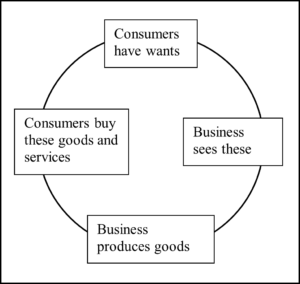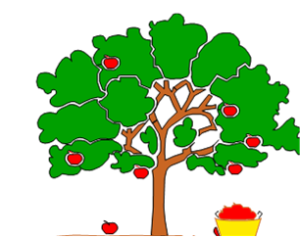Outline the role of business organisations in society
- Business organisations are producers of goods and services.
- Consumers use up – ‘consume’ – goods and services. Consumers may be individuals, communities, other businesses or governments.
- Consumer needs and wants are satisfied when organisations produce goods and services, which consumers can consume.

Consumer Needs and Wants
- Needs are goods and services which consumers must have to survive eg food, clothing and shelter. Most developed countries manage to satisfy basic needs of their populations
- although the government can step in to ensure that basic needs have been met.
- Wants are goods and services over and above those needed for survival eg technology, holidays, cars. The more consumer wants that can be satisfied, the higher the standard of living of
 the consumer.
the consumer. - The government may provide some non-essential products eg transport, but most are satisfied by private organisations operating to make a profit by charging consumers a price.
Goods and Services
- Goods and services are the output of business activity.
- Goods are tangible products which you can see and touch eg a computer, mobile phone, food items, clothes, DVDs.
- Durable goods last for longer than a year eg cars, houses, electrical goods. Non-durable goods last less than a year eg food, shoes.

- Goods may be produced (manufactured) by private or public sector
- Services are products that an individual or organisation provides for you. These include public sector services provided by the government eg health, education, social work, leisure services, police, ambulance, fire brigade.

- Services are also provided by private companies on a profit-making basis eg catering, hotels, travel, banking, Internet services, haircut, utilities (phone, electricity, gas), car repairs, cleaning, retailing (shops).
- Other services are provided by charities and social enterprises eg sporting, social or religious groups. These may be additional to those provided by the government eg the charity Help the Aged offering services to senior citizens on top of those offered by social services.
- A key difference between a good and a service is that goods are tangible – you can see and touch them – whereas services are intangible – you cannot touch them and sometimes you cannot even see them eg electricity.
Factors of Production
To produce goods and services businesses use resources – also known as factors of production. These are the inputs for business activity. The factors of production are land, labour, capital and enterprise.
- Land – natural resources – raw materials used in the production of goods. Examples include coal, oil, timber, metals, fish, water, crops, and livestock.

- Labour – human resources – workers who produce goods eg factory workers, farmers. For services, labour will deliver the service eg electrician, hairdresser, shop worker.

- Capital – man-made resources – machinery or equipment used to produce a good or deliver a service. This includes premises, factory equipment, vehicles, fixtures and fittings. These can be referred to the assets of a business.

- Enterprise – a role of an entrepreneur is to organise the other factors of production so that goods and services are produced.
How Businesses Satisfy Wants
Business organisations see the needs and wants that consumers have and produce goods and services to meet these needs and wants.
Consumers buy the goods and services and their needs and wants are satisfied by consuming these products.
The cycle is a continual process because consumer wants are unlimited.

Sectors of Industry
PRIMARY SECTOR |
Primary sector industries are responsible for extracting natural resources (land/raw materials) which can be used by other organisations to produce goods and services. Examples of primary industries: oil exploration, mining, fishing, farming, forestry. |
|---|---|
SECONDARY SECTOR
|
Secondary industries take the raw materials extracted in the primary sector and they use them to manufacture goods eg electrical goods, food, clothing etc. Construction is also a secondary industry – eg road building, house building. |
TERTIARY SECTOR  |
Tertiary industries are service sector industries which distribute and sell finished goods manufactured in the secondary industry eg road haulage, retailing. Other examples of tertiary sector services include – gas, electricity, telephone, internet services, health, education, holidays, tourism etc. |
Wealth Creation / Value Added
- Goods pass along a chain of production. Primary industries extract raw materials which secondary industries use to manufacture goods. Finished products pass to tertiary sector for distribution and selling.
- The wealth of a country is measured by the value of goods and services produced. More business activity means greater value of goods and services produced, and greater wealth of the country.
- As goods move to the next stage in a production chain, value will be added. The value added is the measure of increased wealth.

Sectors of the Economy
- Private Sector: profit making organisations owned and controlled by private individuals or groups of people. These include sole traders, partnerships and limited companies.
- Public Sector: not-for-profit organisations owned and controlled by the government. These may be central government or local government departments.
- Third Sector: not-for-profit organisations owned and controlled by private individuals or groups of people. These include charities and social enterprises.


